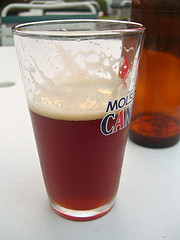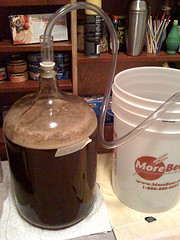Brewing Résumé

My first brew
I ventured into homebrewing in October 2008, and judging by my brewing logs, I’ve made 16 batches since then, which is somewhat less often than once a month. I’m glad I kept the logs from the very start (using Beer Alchemy), because it allowed me to go back and look at the recipes as well as the notes I kept for each batch.
My first kit was an English-style Best Bitter ale from MoreBeer, and boy was I nervous when reading all the steps to be followed during cleaning, sanitizing, steeping, boiling, cooling, fermenting, and bottling. Being a perfectionist, I didn’t want to screw any of it up, but my good friend Sean Coates — a much more experienced brewer — told me, “Relax, beer wants to be made.” What he meant is that even if I did screw something up, the end result would most likely still be beer. This brings to mind another saying in the homebrewing world that was popularized by Charlie Papazian, “Relax, don’t worry, have a homebrew,” or RDWHAHB.
Well, my first beer turned out to be drinkable and actually pretty good. Encouraged by that success and the approach of the holidays, I bought another kit, a Christmas Ale. Brewed together with Gene X, it also came out well, and so I was off. Over the next few months, I scoured homebrewing boards for advice and recipes, and I brewed everything from Dunkelweizen (Tim‘s favorite) to Rye IPA (Jordan‘s favorite) to a smoked porter (no one’s favorite, but still good). I also migrated from using extract with steeping grains to doing partial mashes.
In March of 2009, I was in Montréal for a PHP conference and was introduced to the local brewing scene by Sean. I especially liked the Dieu du Ciel brewery. The second time we visited it, I tried their Aphrodisiaque stout, and, rumor has it, exclaimed, “This is delicious! I dub it The Panty Peeler, and I’ll have to brew a clone of it.” A few weeks later, I did just that, and while I didn’t quite clone it, the result was immensely popular with the female contingent. 🙂

Fermenting beer
Jamil’s Amber-Red Ale was my last partial mash beer, but also my most winning one, since it got 3rd place in the American Amber category at the 2009 Puget Sound Pro-Am competition. After that, I switched to all-grain brewing and haven’t looked back.
My friends Joe, Laura, and a few other local geeks from Michigan, are huge fans of Bell’s Oberon, an American wheat ale. Seeing as Oberon is not available west of the Rockies, I decided to try to clone it as well. The challenge was that Bell’s uses a unique yeast for fermentation, but since they also bottle condition with it, I was able to culture a starter from a single bottle of the beer. With that yeast and a supposedly authentic recipe for Oberon, I made the batch and the result was quite good, if not quite Oberon-like.
My next challenge was Berliner Weiße, an authentic German beer with a sour, refreshing, low-alcohol profile. I wanted to make it with the traditional sour mash technique (instead of using Lactobacillus culture). This involves keeping the mash at 100°F for a couple of days while it sours due to deliberate contamination by bacteria living on the surface of barley. Towards the end, the mash smelled like old gym socks filled with stinky cheese, but it tasted great. After a quick boil and fermentation, I had some really delicious sour beer that would be excellent for summer.
I developed a taste for saisons, so I wanted to try my hand at making one. My version involved a recipe from Brewing Classic Styles, a pinch of spices, and the newly acquired FermWrap heater. Well, my creation was not as dry and spicy as saisons should be, but the aroma and taste were excellent. I entered it in the World Cup of Beer competition as a Belgian Pale Ale, and it scored 34.6 out of 50, lacking just 0.4 points for a 3rd place finish. Better luck next time.
Lacking a refrigeration unit, I hadn’t made lagers yet, but I really enjoy Baltic Porters, so I brewed a batch from BCS again, and asked Brien to ferment it in his temp-controlled freezer. Recently — after a month in the primary, and 10 weeks of lagering — the porter was bottled. Preliminary tasting shows a bit of fusel alcohols, but hopefully that’ll mellow out with some aging.
And finally, my last batch was Hopcode Cache Rye IPA, a recipe from Sean. The name is a play on words. I dry hopped it with Amarillo (one of my favorite hops), and it turned out great, so I entered it into the Alameda County Fair competition. The judging is expected to happen on June 12.
What comes next? Well, that’s a topic for another post. But here’s my brewing résumé so far, in chronological order (recipes in Beer Alchemy format).
- MB Best Bitter.html (recipe)
- MB Christmas Ale.html (recipe)
- Vanilla Cream Ale.html (recipe)
- Deathbrewer’s Dunkelweizen.html (recipe)
- Jamil’s Scottish 60 Shilling (recipe)
- Bee Cave Brewery Rye IPA.html (recipe)
- Loon Lake Smoked Porter.html (recipe)
- Aphrodisiaque clone.html (recipe)
- Jamil’s Amber-Red Ale.html (recipe)
- Cloneberon.html (recipe)
- Belgian Pale Ale (Tweaked from BCS and HBT).html (recipe)
- Berliner Weiße.html (recipe)
- Flossmoor Station Pullman Brown.html (recipe)
- Saison.html (recipe)
- Baltic Porter.html (recipe)
- Hopcode Cache.html (recipe)
![Reblog this post [with Zemanta]](http://img.zemanta.com/reblog_c.png?x-id=e9adf3c1-74b8-4f6b-9fb2-441b8845b5fc)